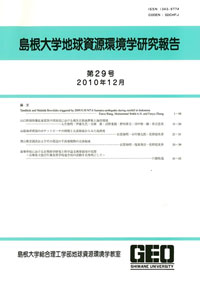島根大学総合理工学部地球資源環境学教室
ISSN:1343-9774

number of downloads : ?
Use this link to cite this item : https://ir.lib.shimane-u.ac.jp/7334
Geoscience reports of Shimane University 29
2010-12-27 発行
Tandikek and Malalak flowslides triggered by 2009.9.30 M7.6 Sumatra earthquake during rainfall in Indonesia
Wang, Fawu
Wafid A.N., Muhammad
Zhang, Fanyu
File
Description
Four earthquakes with magnitudes greater than M7.6 occurred in West Sumatra, Indonesia between 2004 and 2009. The M7.6 earthquake that occurred on 2009.9.30 was the smallest among them. Nevertheless, it triggered many flowslides in the Tandikek and Malalak districts and caused numerous fatalities. To investigate the mechanisms of the occurrence and rapid motion of these slides, we carried out field investigations and laboratory tests.
Our investigations found that flowslides occurred on steep slopes mantled by a pumice layer. A stiff clay layer with low permeability was present beneath the pumice. The most important factor was that it had been raining for three hours before the earthquake occurred, although the rainfall was of medium intensity. Laboratory tests on pumice samples with ring shear apparatus showed that: (1) The pumice layer was easily crushed; (2) The pumice layer could remain stable even in strong rainfall; (3) The pumice layer could resist strong earthquake motions in dry conditions; (4) Under fully saturated and undrained conditions, the pumice layer could be liquefied by earthquake triggering.
This study shows the worst scenario of the combination of rainfall and earthquake in the distribution area of the pumice, and calls for attention to a new type of geo-hazard.
Our investigations found that flowslides occurred on steep slopes mantled by a pumice layer. A stiff clay layer with low permeability was present beneath the pumice. The most important factor was that it had been raining for three hours before the earthquake occurred, although the rainfall was of medium intensity. Laboratory tests on pumice samples with ring shear apparatus showed that: (1) The pumice layer was easily crushed; (2) The pumice layer could remain stable even in strong rainfall; (3) The pumice layer could resist strong earthquake motions in dry conditions; (4) Under fully saturated and undrained conditions, the pumice layer could be liquefied by earthquake triggering.
This study shows the worst scenario of the combination of rainfall and earthquake in the distribution area of the pumice, and calls for attention to a new type of geo-hazard.
Other Article
